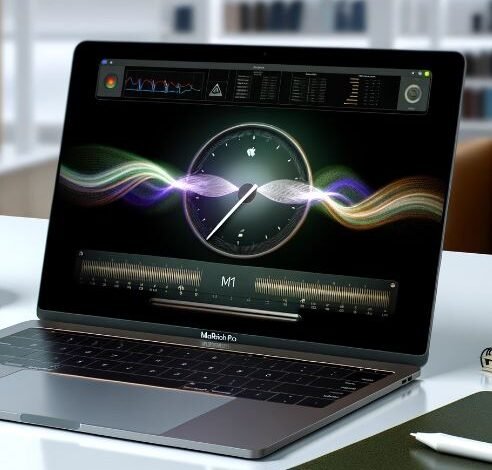
Introduction
The launch of the MacBook Pro M1 marked a significant milestone in Apple’s computing legacy, introducing the world to the unprecedented power of Apple Silicon. In Pakistan, where the tech market is as dynamic as it is diverse, the MacBook Pro M1 has stirred considerable interest among professionals, creatives, and tech enthusiasts. This article explores the MacBook Pro M1’s features, performance benchmarks, and, most crucially, the MacBook Pro M1 price in Pakistan, offering insights into what buyers can expect in terms of value, performance, and cost.
The Dawn of Apple Silicon
Overview of Apple Silicon and the M1 chip
The M1 chip, built on a 5nm process technology, integrates 16 billion transistors into a single SoC (System on a Chip). It features an 8-core CPU, split between four high-performance cores and four high-efficiency cores, an 8-core GPU, and a 16-core Neural Engine capable of executing 11 trillion operations per second. This integration allows for optimized computing power and battery life, setting a new standard for performance per watt.
The MacBook Pro M1’s debut and its impact on the tech industry
The launch of the MacBook Pro with the M1 chip was met with acclaim and astonishment. It outperformed not only its Intel-based predecessors but also many competitors in the same price range. Benchmark tests revealed that the M1 MacBook Pro could handle intensive tasks like video editing, 3D rendering, and software development with unprecedented ease, all while offering up to 20 hours of battery life — the longest ever in a Mac.
Design and Build: The Iconic MacBook Pro Aesthetic
A detailed look at the MacBook Pro M1’s design features
The M1 MacBook Pro boasts a 13.3-inch Retina display, renowned for its vibrant colors, sharp text, and incredible detail with a resolution of 2560 x 1600 pixels. This display is supported by P3 wide color gamut and True Tone technology, which adjusts the screen’s color temperature based on ambient lighting, offering a more natural viewing experience.
One of the most lauded design features of the MacBook Pro M1 is its Magic Keyboard. After feedback on the butterfly mechanism, Apple reverted to the scissor-switch design, offering a more reliable and comfortable typing experience. The keyboard also includes a dedicated Escape key and a Touch Bar, providing shortcuts and tools right at the user’s fingertips.
Comparisons to previous Intel-based models
When compared to its Intel-based predecessors, the MacBook Pro M1 maintains the external design ethos that Apple is known for but introduces a significant leap in performance and efficiency thanks to the Apple Silicon. The Intel models, while powerful in their own right, were often criticized for heat management issues and battery life limitations under heavy workloads. The M1 chip’s high efficiency dramatically extends battery life—up to 20 hours of web browsing, a figure that was previously unheard of in the MacBook Pro lineup.
Performance Unleashed: The M1 Chip in Action
Benchmarks and real-world performance analysis
Benchmarks of the MacBook Pro with the M1 chip have consistently shown it outperforming not only its Intel-based predecessors but also competing laptops in many categories. In CPU-intensive tasks, such as video encoding with Handbrake or image processing in Adobe Photoshop, the M1 MacBook Pro demonstrates remarkable speed improvements, often completing tasks in half the time of Intel-based models.
Software compatibility and the Rosetta 2 translation layer
Rosetta 2 works by translating Intel app instructions into M1-compatible instructions at the time of installation or on the fly when the app is run. This process is remarkably efficient, with many users reporting that Intel-based apps run just as well, if not better, on M1 Macs under Rosetta 2 than on native Intel Macs. This seamless transition has been crucial in the M1’s adoption, ensuring that users can continue to use their favorite software without waiting for developers to release ARM-native versions.
Pricing Dynamics in Pakistan
Factors influencing the MacBook Pro M1’s price in Pakistan
Factors Influencing the MacBook Pro M1’s Price in Pakistan
Import Duties and Taxes:
One of the primary factors contributing to the higher price of the MacBook Pro M1 in Pakistan is the import duty imposed by the government on electronic goods, including laptops. These duties can significantly increase the base cost, making the MacBook Pro M1 more expensive than in markets where such taxes are lower or non-existent.
Currency Fluctuations:
The Pakistani Rupee’s fluctuation against the US Dollar directly impacts the MacBook Pro M1’s price. Since Apple prices its products in USD globally, any depreciation in the Rupee leads to an increase in prices when converted, making the MacBook Pro M1 less affordable for the average consumer in Pakistan.
Supply Chain Constraints:
Given Pakistan’s geographical and logistical challenges, including limited direct supply channels from Apple, supply chain constraints can add to the cost. Retailers often have to rely on third-party suppliers who import the MacBook Pro M1, leading to added costs due to middlemen.
Market Demand:
The demand for high-end laptops like the MacBook Pro M1, coupled with a relatively limited supply, can drive prices up. The tech-savvy and professional segments in Pakistan, who are the primary market for the MacBook Pro M1, may find themselves paying a premium due to this demand-supply imbalance.
Comparison with international pricing and regional variations
Navigating the Market: Where to Buy the MacBook Pro M1 in Pakistan
- Authorized resellers vs. gray market options
- Tips for securing the best deals and avoiding scams
MacBook Pro M1 Ownership: A Long-term Perspective
- Assessing the total cost of ownership
- Resale value and market demand for the MacBook Pro M1 in Pakistan
Conclusion
Summarize the MacBook Pro M1’s position in Pakistan’s tech market, emphasizing its revolutionary performance and the considerations buyers should keep in mind regarding its price and availability.



